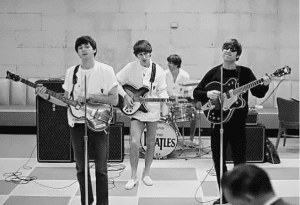5 Things You Didn’t Know About Paul McCartney’s Iconic Beatles Bass

via strangedaysindeed9 / YouTube
Has there ever been a musician as intimately linked to an instrument as Paul McCartney and his Hofner bass? When you come across an image of McCartney, it’s hardly surprising to find him cradling the Hofner; it’s as if the two were destined to be inseparable.
Over the years, every member of The Beatles has been thoroughly scrutinized time and time again. McCartney, in particular, has endured endless examination in connection with his Hofner basses.
This scrutiny has given rise to numerous legends and myths, many of which have become accepted as facts simply due to their longstanding presence.
And with that, let’s take a look at five surprising facts about Macca’s iconic favorite bass.
1. Paul had two Hofners
Paul actually owned two Hofner bass guitars. His original Hofner was a 1961 model, and he exclusively used it until late 1963.
The Beatle’s first bass had several distinctive characteristics, but the most significant difference lies in the pickups. This earlier model, affectionately known as the “Cavern Bass” among fans, featured both pickups near the neck.
By 1963, this Hofner was displaying signs of wear, and Paul even had to resort to using tape to secure a pickup in place. As a result, he acquired a new one, primarily keeping it as a backup.
Sometime in 1964, Paul had the bass refinished, and the sunburst finish on it differed from the Hofner’s original one; it resembled more of a Fender-style finish.
Paul McCartney’s Hofner Bass Guitar. It’s the first bass McCartney would use and one of their most prominent guitars pic.twitter.com/prvpYuOSvs
— 7amoury (@x7amoury) August 12, 2016
2. Paul’s bass was a rare model
Paul’s second Hofner bass is a somewhat uncommon model. This renowned Hofner, the one he continues to play today, can be considered a hybrid model. There are several notable distinctions between this one and his original Hofner: it features a Hofner script logo and strip tuners, as well as an arched back.
It’s probable that Paul’s bass was assembled in the autumn of 1963, utilizing a body that had been manufactured in 1962. Consequently, it is occasionally referred to as a V6-2 by Hofner when producing reproductions.
What makes Paul’s bass especially unique is the fact that the pickups are spaced slightly wider apart. You may have observed that on Paul’s Hofner, the bridge pickup is positioned relatively low and closer to the tailpiece than one would expect.
This variation is due to the handmade nature of these instruments, resulting in some variability between each one. However, this variance certainly alters the instrument’s appearance.
3. Paul’s bass had a guitar strap problem
Initially, Paul’s Hofners lacked a conventional method for affixing a standard guitar strap. This is quite an interesting aspect because when you examine early photos, you’ll notice Paul appearing somewhat awkward. This is due to the fact that these violin basses originally did not have strap buttons.
In one particular photo, Paul can be seen with an acoustic strap ingeniously rigged all the way up to the headstock. Hofner did provide a leather strap, but the method for attaching it was rather peculiar.
Additionally, attaching the strap in this manner would result in a permanent metal part that would probably rub against the finish when placing the instrument in its case. Eventually, Paul settled for using the neck loop method, although he actually clipped directly onto the tailpiece.
This might not have been ideal for his intonation, but honestly, he probably didn’t mind. Since then, Paul has had strap buttons installed. Nevertheless, throughout the Beatlemania era, this was how he played it.
View this post on Instagram
4. Paul’s Hofner is entirely hollow
Did you know that Paul’s Hofner is actually hollow? Surprisingly, many people are unaware of this fact, but these basses are entirely hollow on the inside.
They lack a central block, which makes them exceptionally lightweight. So when people wonder why Paul doesn’t play his Rickenbacker anymore, it’s because he preferred the lighter Hofner as he grew older.
And Paul certainly missed that Hofner woody-sounding thud. Despite its compact size and lightweight build, the Hofner delivers a distinctive, resounding sound with a robust thud.
While it may not cater to every musical style and may not be everyone’s cup of tea, it excels in producing a flat-wound, almost double bass-like tone that you can sense as much as you can hear. It truly stands alone in this regard.
View this post on Instagram
5. Paul’s original Hofner was stolen
Now, this is undoubtedly the most heart-wrenching topic to talk about when one brings up Paul’s beloved bass guitars. Paul’s original Hofner, as it turns out, was stolen, and it remains missing to this day.
Remember that 1961 Cavern Bass Hofner mentioned in this list’s number one? Regrettably, it vanished in 1969. Prior to being stolen, Paul continued to use the bass occasionally even after retiring it a few years prior.
He kept it as a backup for most of his shows, and it became particularly famous when he played it in the Revolution Promo video. It also made appearances numerous times during the Get Back sessions.
It was pilfered during those sessions in 1969, and no one has laid eyes on it since. This is a disheartening misfortune for Beatlemaniacs because this is the original bass that fans hear on so many of the early Beatles classics, from “Twist and Shout” to “She Loves You”.
Interestingly, a team consisting of a guitar specialist and two journalists has recently initiated a worldwide search for Paul’s lost bass guitar, embarking on a mission to unravel what they describe as “the greatest mystery in rock and roll”.












